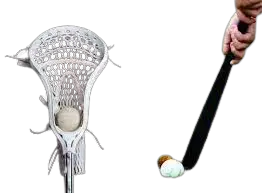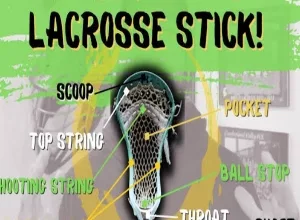Defensive Dominance: The Importance of Tackling in Lacrosse

can you tackle in lacrosse? Read it carefully to understand it's tactics.
I have e experienced my fair share of bumps and bruises throughout my years of playing lacrosse. There's a reason why lacrosse is regarded as a contact sport. There is one question that new lacrosse players often ask me, and it is fairly frequent. Is hitting allowed in lacrosse?
In general, ramming another lacrosse player with your shoulder will cause contact. We call this a body check. You are only permitted to do this if you are in control of the ball, they are in control of the ball, or they are within 5 yards of the ball. To weaken the adversary, this is done.
Speaking from personal experience, being armed by an aggressor is not enjoyable. Some restrictions prohibit lacrosse players from using other forms of contact, even though you are permitted to hit someone by crashing into them. I'll outline the types of hits that are permitted and prohibited in lacrosse in this article.
Can you hit with your shoulder in lacrosse?
In general, rushing into another player when they have the ball or while you have the ball will cause you to strike someone with your shoulder in lacrosse. It is quite OK to ram another player with your shoulder to knock them out of the game.
Remember that shoulder ramming isn't always regarded as a tackle!
- You can crash into your opponent whether you're an attacker, defender, or middle fielder in three different situations:
- whenever the opposing team has the ball
- When you have the ball in your possession
- when the opponent is five yards away from the ball.
One of the most crucial decisions you must make is which lacrosse stick will work best for you. I've owned a lot of lacrosse sticks over the years, but the STX Lacrosse Fortress 700 Complete Stick was the greatest I've ever used. Any lacrosse player can utilize this stick because it includes a Crux Mesh Pro Pocket. On Amazon, you can find this Stick!
Any player who is adjacent to the lacrosse ball is deemed to be, what I term, “an active player,” making it possible to go through or try to knock the ball out. This is why the rules are set up this way.
The officials will penalize you if you ram your opponent with your shoulder when neither of you is anywhere near the lacrosse ball because it was unnecessary to use such unnecessary force.
Shoulder tackles ought to be reserved for game-winning situations and extreme measures. DO NOT, however, strike your adversary with the stick!
Make careful to use your footwork and stick checks to force them to drop the ball before ramming another player. Regarding All The Similarities and Differences Between Men's and Women's Lacrosse, I recently wrote an essay about it. This page outlines the rules for each sport and goes into great detail regarding the actual differences between the two. Check out this article by clicking here!
Can you tackle someone in lacrosse?
In lacrosse, tackling another player is generally prohibited. In the game of lacrosse, tackling is regarded as an unwarranted use of force and is therefore strictly prohibited. Lacrosse players are allowed to body check to knock the ball out of the sticks rather than tackle.
Many inexperienced lacrosse players think the sport is played similarly to American football. Even though there are some similarities, lacrosse is viewed as a very separate sport!
The 10-on-10 format of Ezoic Lacrosse allows for a maximum of 13 players to be on one half of the field at once. This makes it incredibly simple to accidentally collide with someone and receive a ticket.
Sincerely, if you ever unintentionally tackled someone in the field, I wouldn't hold it against you. When you're a defense in lacrosse, it may get stressful at times!
Try to master your body-checking technique so that you can knock the ball out of the opposing player's stick rather than tackling.*The question of whether you can play lacrosse while wearing glasses may arise if you wear spectacles. I recently prepared an article explaining whether or not you should wear lacrosse goggles during a game as well as if you should wear glasses to a lacrosse game. Check out this article by clicking here!
Can you hit someone in lacrosse?
You CANNOT use your lacrosse stick to strike another player. This will be considered a cross-check or slash, which are prohibited moves in which your stick makes contact with another player. You may, however, strike another player's stick with your own. An example of this is a stick check.
Your stick cannot make contact with another player in lacrosse:
In a lacrosse game, checking indicates that you are permitted to make some type of contact. In lacrosse, two distinct checks are acceptable:
Sticks check and body checks:
Stick Check: To move the ball during a stick check, you may hit your opponent's stick with your own.
Body Check: During a body check, you are permitted to ram your opponent with your shoulder or both hands on the stick while keeping your distance from them to no more than 6 inches. Anything more will be considered a cross-check.
*As a side note, I recently wrote an article about whether playing lacrosse is a fun sport. This article examines the ease of learning lacrosse as well as the rules of the game. Check out this article by clicking here!
Slashing vs. Checking in lacrosse:
Checking and slashing are not the same thing. When you swipe the stick and make contact with the body of another player, you are slashing. Due to the potential for significant injuries, this is forbidden in lacrosse. I've witnessed a lot of players in lacrosse who unintentionally slash their opponents, earning them a penalty from the officials.
When performing a stick check, every lacrosse player needs to be cautious because if you miss, you could hit the player with your stick and be punished with slashing. By the way, I just published a piece about whether a lacrosse stick can break a bone. This article discusses the likelihood of breaking a bone when struck by a lacrosse stick as well as what to anticipate. Check out this article by clicking here!
Conclusion: Can You Tackle in Lacrosse? Defining the Game's Heart
In the world of lacrosse, the question isn't just about whether you can tackle; it's about understanding the essence of the game. Through this exploration, we've delved into the complexities of tackling, demystifying it from a mere physical act to an art form that epitomizes strategy, precision, and teamwork.
Tackling in lacrosse isn't a solitary endeavor; it's a collaborative effort that binds players and teams together. It’s a blend of anticipation, technique, and split-second decision-making. By grasping the rules and mastering various forms of tackles, players transform into defenders of their team’s legacy on the field.
Our journey through the FAQs has highlighted the importance of legal and effective tackling. It's more than a defensive tactic; it's a statement of sportsmanship and respect for the game. As players, coaches, and enthusiasts, our responsibility extends beyond the boundaries of the field. It's about nurturing the spirit of fair play, ensuring that every tackle embodies the essence of the sport.
For those new to lacrosse, this insight serves as a gateway into a world where physicality meets finesse, where athleticism meets intellect. For seasoned players, it's a reminder of the perpetual refinement required to stay at the top of the game.
As we conclude, remember that tackling isn’t just a skill; it's a testament to the dedication and passion lacrosse players bring to every match. It's a testament to the camaraderie among teammates, the guidance of coaches, and the support of fans. Whether you’re a player striving for perfection, a fan cheering from the stands, or a curious mind eager to understand the sport, tackling in lacrosse is more than a question – it’s the very heartbeat of the game. Embrace it, respect it, and let it inspire you, for in the world of lacrosse, the ability to tackle isn't just a challenge; it's an invitation to truly comprehend the soul of this exhilarating sport.
Certainly! Here are some FAQs (Frequently Asked Questions) related to tackling lacrosse for your blog post:
1. What is a tackle in lacrosse?
A tackle in lacrosse refers to a defensive move where a player uses their body or stick to legally block, push, or dispossess an opponent carrying the ball, aiming to regain possession for their team.
2. Are there specific rules for tackling lacrosse?
Yes, there are specific rules governing tackling in lacrosse. Players must avoid excessive physicality and adhere to guidelines about body checking, stick checking, and other defensive maneuvers to ensure fair play.
3. When is a tackle considered legal in lacrosse?
A tackle is considered legal in lacrosse when it is executed within the defined rules of the game. Legal tackles involve proper body positioning, stick checks, and controlled physical contact. Illegal tackles can result in penalties for the player and their team.
4. What are the different types of tackles in lacrosse?
Lacrosse tackles can vary, including body checks, stick checks, wrap checks, and poke checks. Each type has its specific technique and purpose, and players often use a combination of these tactics to defend against opponents.
5. Can tackling in lacrosse lead to injuries?
While lacrosse is a physical sport, players are trained to tackle safely and within the rules. Adhering to proper techniques reduces the risk of injuries. However, like any contact sport, there is always a potential for injuries, which is why players wear protective gear.
6. What are some tips for effective tackling in lacrosse?
Effective tackling in lacrosse requires good timing, anticipation, and defensive skills. Players should focus on footwork, stick positioning, and body control to execute successful tackles. Teamwork and communication with teammates also play a crucial role in defensive strategies.
7. Can players be penalized for illegal tackles in lacrosse?
Yes, players can be penalized for illegal tackles in lacrosse. Penalties can result in the offending player serving time in the penalty box, giving the opposing team an advantage. Repeated offenses may lead to more severe penalties and potential ejection from the game.
8. How can players improve their tackling skills in lacrosse?
Players can enhance their tackling skills through practice, drills, and proper coaching. Working on agility, strength, and defensive techniques can significantly improve a player's ability to tackle effectively and legally during games.
9. What role does tackling play in the overall strategy of a lacrosse game?
Tackling is a fundamental aspect of lacrosse defense. It helps disrupt the opponent's offensive plays, regain possession of the ball, and create scoring opportunities for the defending team. A strong defensive game, including effective tackling, is essential for a team's success in lacrosse.
10. Are there differences in tackling rules between men's and women's lacrosse?
Yes, there are differences in tackling rules between men's and women's lacrosse. Men's lacrosse allows for more physical contact, including body checking, while women's lacrosse has stricter regulations to prioritize player safety. Understanding these differences is crucial for players and fans of both versions of the game.




